[vc_row][vc_column][vc_column_text]At some point every spring, trout in the Missouri River start eating a lot of crawfish. It is difficult to know exactly when this will happen, but below are some facts that should aid in your angling success.[/vc_column_text][us_image image=”27228″ align=”center”][/vc_column][/vc_row][vc_row][vc_column][vc_column_text]
The Spring Spawn
During the spring, when water temperatures rise into the 50s, male crawfish begin looking for receptive females to mate with. This usually occurs sometime between February and May.
During this time, the males become reckless. They will commonly walk on top of rocks rather than sneaking around underneath them. This makes them vulnerable to predation and freely available to trout. During this time period, crawfish fly patterns are maximally effective.
Crawfish prefer to mate in rocky areas where rocks are at least 6″ in diameter. Riprap banks are a prime example of this kind of habitat. Although there are some rocky areas above Craig, there is more of this habitat downstream of the Dearborn River confluence.[/vc_column_text][/vc_column][/vc_row][vc_row][vc_column][vc_column_text]
The Post Spawn Period
After spawning, females enter a burrow and begin generating eggs. The males molt and then resume their typical reclusive patterns. The eggs hatch after about one month, but the juveniles remain attached to the mother until they are about 1/2″ in length. Then young crawfish continue growing and molting until they reach a maximum size of about four inches. They have an average maximum lifespan of two to three years.[/vc_column_text][/vc_column][/vc_row][vc_row][vc_column][vc_column_text]
Crawfish Fly Patterns
Below are some popular crawfish fly patterns that we carry in the shop. You can order the Clouser Crayfish or a Just Add “Vise” Kit for the same pattern in our online store.
Most of these patterns are designed to be dead-drifted or twitched occasionally. If you’re looking for a pattern that can be stripped more rapidly, Kraft’s Crawdad and a bunch of different wooly bugger patterns will keep you covered.[/vc_column_text][/vc_column][/vc_row][vc_row][vc_column][us_image image=”27566″ align=”center” meta=”1″][/vc_column][/vc_row][vc_row][vc_column][us_image image=”27567″ align=”center” meta=”1″][/vc_column][/vc_row][vc_row][vc_column][vc_column_text]If you don’t have any of these patterns in your fly boxes, you should add some and keep them handy for the next month.[/vc_column_text][/vc_column][/vc_row]

Also, carp food!
Good article, Braden. Don’t sleep on the good ole J.J. Special.